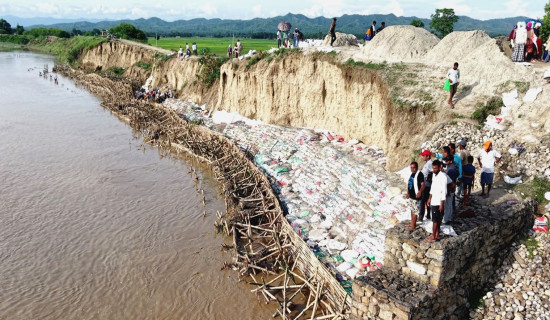- Wednesday, 16 July 2025
Burning Plastic Waste Harms Health
Burning plastic smells dreadful. In recent weeks, instances of burning garbage have gone up. It is commonly seen that garbage accumulated being burnt in open spaces. The main cause of concern is the burning of plastic bottles, carry bags, and other hazardous waste mixed with other non-degradable garbage.
Burning plastic waste results in harmful gases that may cause many health hazards, including cancer. Burning of garbage may lead to the waste being reduced in terms of volume, but the method has been associated with newly acknowledged problems often harmful for health and the environment. The smoke it produces may cause a choking feeling. Plastics are made up of oil and produce toxic fumes when they are burnt.
Production
The World Economic Forum has estimated that plastic production is expected to double in the next 20 years. At the same time, plastic recycling rates is minimal as it is around 30 per cent in Europe, a mere nine per cent in the U.S., and zero or close to it in most low- and middle-income countries.
Another common practice in developed economies is to incinerate plastics and other waste through sophisticated incinerators. It results in heat and steam rotating turbines to generate electricity. The electricity produced is fed to the local grid and utilised. Most of developed economies prohibit landfilling of organic waste. At present, European Union burns around 42 per cent of its waste while the U.S. burns 13 per cent and generates electricity.
Plastic pollution has turned into one of the most pressing environmental and health issues owing to its increasing use. It has been estimated that every year over 400 million metric tons of plastic waste is generated globally, the majority of which is dumped in landfills. Estimates say around 80 per cent of plastic products end up accruing in landfills or the environment, while only about 12 per cent are incinerated.
Owing to insufficient infrastructure, developing countries are often unable to responsibly manage plastic waste while many developed countries continue to have low recycling rates. Most countries struggle to properly collect and manage the quantity and diversity of discarded plastic waste.
The burning of plastics and other domestic waste is commonly seen in many countries in the world. People burn plastics for various reasons. They find it easier to burn plastics than transporting them to the disposal site or avoiding paying for waste collecting service or there exists no waste collection service or there is no alternative than to burn it as happens in many rural areas.
China has the largest number of waste-to-energy plants, with more than 300 such plants operating, and another several hundred in the pipeline. China used to accept foreign waste for recycling in the past, and in 2018, it stopped accepting any more foreign waste for recycling (BBC, 2018).
Toxic gases like dioxins, furans, mercury, and polychlorinated biphenyls (better known as BCPs) are released into the atmosphere with the burning of plastic waste. Such gases pose a threat to vegetation, and human and animal health. Therefore, the burning of plastic waste in an open field has become a major source of air pollution. It is commonly seen that Municipal Solid Waste (MSW), which contains about 12 per cent of plastics, is burnt even in landfill sites releasing toxic gases and polluting the air and contributing to climate change.
In order to reduce the amount of plastic waste that usually ends up in landfills, rivers, and oceans, in 2019, European Union promulgated a law to ban single-use plastic items such as single-use plastic plates, plastic straws, and plastic cutlery, from 2021. Many countries have banned single-use plastic products and Nepal banned plastic bags below the thinness of 40 micros in 2022.
Dioxins settle on crops and enter waterways where they eventually enters our food and hence our bodies. These dioxins are potentially lethal persistent organic pollutants that can cause cancer and disrupt the thyroid and respiratory systems. A chemical that gives plastic flexibility and softness, phthalates are endocrine disruptors has been associated with a plethora of health problems, ranging from fertility issues to allergies and asthma.
The toxic gas also affects the kidney or the liver, in the reproductive and development system. The toxic gas resulting from the burning of plastic waste has been implicated to increase the risk of heart disease, aggravates respiratory diseases such as asthma and emphysema and damages the nervous system. Burning plastic products releases black carbon that contributes to climate change and air pollution.
Ban
Burning plastic waste is a common practice among Nepalese. It is considered a quick and easy solution to reduce overflowing garbage but is associated with many health problems besides environmental degradation. In a bid to decrease air pollution and improve public health, the Kathmandu Metropolitan City (KMC) has issued a notice asking people not to burn waste in the open and it is expected that all the municipalities throughout the country follow suit.
Most people who burn domestic plastic waste do not realize how harmful this practice is to their health and to the environment. Therefore, a large-scale awareness campaign throughout the country is essential. It is up to the public to realize the harmful effects of burning plastic waste in open. Furthermore, if you see plastics being burned in your neighborhood, or in the open field, don't watch, raise your voice against it. It kills the environment, your health, and the health of our coming generation, let's save it for them.
(Dr. Lohani is the clinical director at the Nepal Drug and Poison Information Centre. lohanis@gmail.com)

















